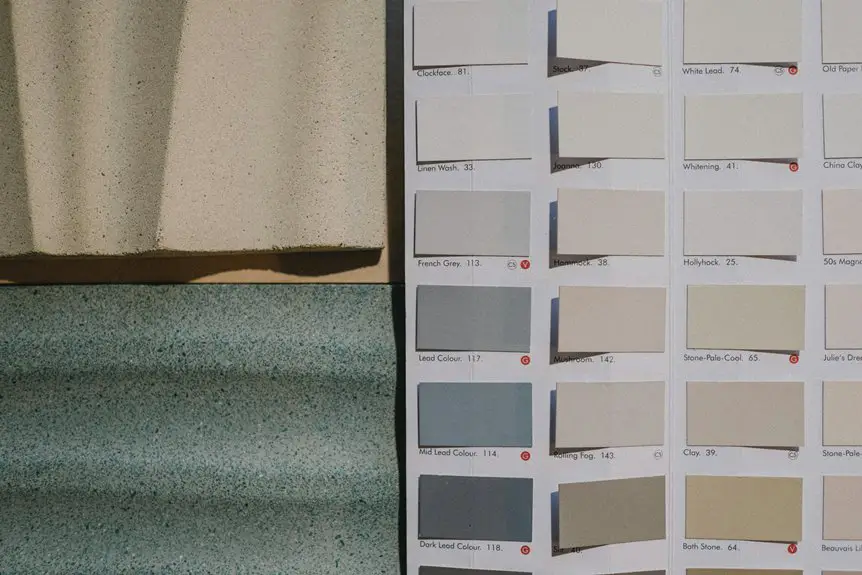If you need lightweight, impact-resistant protection, Kevlar is your go-to with its high tensile strength and heat resistance up to 450°C, making it ideal for body armor, aerospace, and sporting gear. Fiberglass, denser and more brittle, excels in marine, automotive, and construction for its durability and higher thermal tolerance near 700°C. Both offer strong advantages depending on your project’s demands, and exploring their details reveals how each material shines in different environments.
Table of Contents
Key Takeaways
- Kevlar is preferred for body armor, aerospace, and protective clothing due to its high impact resistance and lightweight properties.
- Fiberglass is widely used in boat hulls, automotive panels, and construction for its corrosion resistance and thermal insulation.
- Kevlar excels in applications requiring high tensile strength and heat resistance up to 450°C, such as industrial gloves and helmets.
- Fiberglass withstands higher temperatures (around 700°C) and offers better chemical and corrosion resistance in marine and industrial environments.
- Fiberglass is more cost-effective and easier to recycle, making it suitable for large-scale construction and manufacturing projects.
History and Development of Kevlar and Fiberglass
Although you might know Kevlar and fiberglass as strong materials used today, their histories began decades ago with distinct paths.
Kevlar was developed in the 1960s by Stephanie Kwolek at DuPont, aiming to create a lightweight yet incredibly strong fiber for tires. Your use of Kevlar evolved quickly into body armor and aerospace applications due to its exceptional strength-to-weight ratio.
On the other hand, fiberglass traces back to the 1930s when Owens-Corning pioneered glass fiber production for insulation. You’ll find fiberglass gaining popularity in construction, automotive, and marine industries thanks to its durability and flexibility.
Both materials revolutionized their sectors, but their development timelines and initial purposes reflect unique innovations that continue to influence how you rely on them today.
Chemical Composition and Structure
When you examine Kevlar and fiberglass closely, you’ll notice their chemical compositions and structures set them apart fundamentally.
Kevlar is an aramid fiber, made from long chains of poly-paraphenylene terephthalamide molecules. These chains align tightly, creating strong hydrogen bonds that give Kevlar its exceptional tensile strength and durability.
Fiberglass, on the other hand, consists of fine strands of glass, primarily silica (SiO2), combined with other oxides like calcium and aluminum. Its structure is amorphous, lacking the ordered molecular arrangement you see in Kevlar.
This difference means Kevlar’s molecular chains run parallel and reinforce each other, while fiberglass’s glass fibers rely on their physical form rather than molecular bonding for strength.
Understanding these distinctions helps you choose the right material based on chemical and structural advantages.
Mechanical Properties Comparison
When you compare Kevlar and fiberglass, you’ll notice clear differences in tensile strength that affect their performance.
You’ll also find that their impact resistance varies, influencing how each material responds under stress.
Understanding these mechanical properties helps you choose the right material for your needs.
Tensile Strength Differences
Because tensile strength determines how much pulling force a material can handle before breaking, it’s crucial to compare Kevlar and fiberglass in this regard.
Kevlar boasts a tensile strength of around 3,620 MPa, making it incredibly strong under tension. Fiberglass, while also durable, typically has a tensile strength closer to 2,400 MPa. This means Kevlar can handle considerably greater stress without snapping, which is why it’s favored in applications requiring exceptional strength-to-weight ratios, like body armor and aerospace components.
If your project demands lightweight materials that resist stretching and breaking under heavy loads, Kevlar often outperforms fiberglass.
However, fiberglass still offers respectable tensile strength at a lower cost, making it suitable for less demanding structural uses where extreme strength isn’t critical.
Impact Resistance Comparison
Although both Kevlar and fiberglass offer strong mechanical properties, their impact resistance differs markedly, which can influence your choice depending on the application.
Kevlar excels in absorbing and dispersing energy from high-velocity impacts, making it ideal when you need superior protection against sudden shocks. Fiberglass, while durable, tends to be more brittle under impact stress and can crack or shatter.
Consider these key points when comparing impact resistance:
- Kevlar’s high tensile strength fibers provide exceptional resistance to penetration and blunt force.
- Fiberglass offers good impact resistance but may fail catastrophically under severe conditions.
- Kevlar maintains structural integrity better during repeated impacts, whereas fiberglass can degrade faster.
Choosing between them depends on whether you prioritize flexibility and toughness or cost and rigidity.
Weight and Density Differences
Since you’re comparing Kevlar and fiberglass, understanding their weight and density differences is essential.
Kevlar is considerably lighter than fiberglass, with a density around 1.44 g/cm³ compared to fiberglass’s roughly 2.5 g/cm³. This means Kevlar offers a better strength-to-weight ratio, making it ideal when you need strong materials without added bulk.
Kevlar’s lower density around 1.44 g/cm³ makes it significantly lighter than fiberglass at 2.5 g/cm³.
If weight is a critical factor in your project, Kevlar will help you keep things lighter and more manageable.
On the other hand, fiberglass’s higher density can add durability but at the cost of increased weight.
Impact and Abrasion Resistance
When you consider impact resistance, Kevlar tends to absorb shocks better than fiberglass.
You’ll also notice that Kevlar offers superior abrasion durability, making it ideal for rough conditions.
Let’s explore how these differences affect their performance in real-world applications.
Impact Resistance Capabilities
Impact resistance plays an essential role in choosing between Kevlar and fiberglass, especially if you’re looking for materials that can withstand drops, hits, or rough handling.
Kevlar excels in absorbing and dispersing impact energy due to its high tensile strength and flexibility. Fiberglass, while strong, tends to be more brittle and may crack under severe impact.
Consider these factors when evaluating impact resistance:
- Kevlar resists penetration from sharp or blunt forces better than fiberglass.
- Fiberglass offers good stiffness but less energy absorption during impacts.
- Kevlar’s woven structure provides superior toughness and resilience under dynamic loads.
If your project demands superior impact protection, Kevlar is often the better choice.
However, fiberglass can suffice when moderate impact resistance and cost efficiency are priorities.
Abrasion Durability Comparison
Although both Kevlar and fiberglass offer strong resistance to wear, Kevlar outperforms fiberglass in abrasion durability thanks to its unique fiber structure and flexibility.
When you choose Kevlar, you get a material that resists cuts, scrapes, and repeated friction much better. Its tightly woven aramid fibers absorb and distribute stress, preventing surface damage over time.
Fiberglass, while tough, tends to crack or splinter under constant abrasive forces, reducing its lifespan in high-wear environments.
If your application involves rough handling or exposure to abrasive elements, Kevlar will maintain integrity longer.
Thermal and Fire Resistance Capabilities
Since heat resistance plays an important role in many applications, understanding how Kevlar and fiberglass perform under high temperatures is essential.
You’ll find that Kevlar maintains its structural integrity up to about 450°C but begins to degrade beyond that, while fiberglass can withstand temperatures around 700°C without significant damage.
Both materials offer good fire resistance, but their behavior differs under extreme conditions.
Here’s what you need to know:
- Kevlar resists ignition and slows flame spread, making it ideal for protective gear.
- Fiberglass is non-combustible and tolerates prolonged exposure to heat.
- Kevlar’s thermal degradation produces less smoke compared to fiberglass.
Cost Analysis and Economic Considerations
Understanding the thermal and fire resistance of Kevlar and fiberglass gives you insight into their performance, but cost plays a big role in deciding which material fits your budget and project needs. Kevlar generally costs more upfront due to its superior strength and durability, making it ideal for high-performance applications. Fiberglass, on the other hand, offers a more affordable option with decent strength, suitable for budget-conscious projects.
| Factor | Kevlar |
|---|---|
| Material Cost | Higher ($$$) |
| Installation Cost | Moderate |
| Maintenance | Low |
| Lifespan | Long |
| Overall Value | High for durability |
| Factor | Fiberglass |
| Material Cost | Lower ($) |
| Installation Cost | Low |
| Maintenance | Moderate |
| Lifespan | Moderate |
| Overall Value | Good for budgets |
Environmental and Sustainability Factors
When you weigh environmental and sustainability factors, both Kevlar and fiberglass offer distinct benefits and challenges.
Kevlar, being a synthetic aramid fiber, requires energy-intensive production but boasts strong durability, reducing the frequency of replacement.
Fiberglass, made from abundant silica sand, is easier to recycle but involves emissions during manufacturing.
Consider these key points:
- Production Impact: Kevlar’s complex synthesis consumes more energy than fiberglass’s melting and spinning process.
- Longevity: Kevlar’s high strength extends product life, minimizing waste.
- Recyclability: Fiberglass can be reclaimed and reused more readily, while Kevlar recycling remains limited.
Common Industrial and Commercial Uses of Kevlar
Kevlar plays an essential role in various industries thanks to its exceptional strength and lightweight nature. When you need reliable protection, Kevlar is your go-to for body armor and bulletproof vests, providing life-saving defense without restricting movement.
In automotive and aerospace sectors, Kevlar’s durability and resistance to impact help enhance vehicle safety and fuel efficiency. You’ll also find Kevlar in sporting goods like helmets and racquets, where it boosts performance and protects against injury.
Additionally, Kevlar’s heat resistance makes it ideal for industrial gloves and protective clothing, safeguarding workers in hazardous environments. If you require strong, lightweight reinforcement, Kevlar’s versatility and resilience make it invaluable across these demanding commercial and industrial applications.
Typical Applications of Fiberglass
Although fiberglass may not be as strong as Kevlar, it offers excellent versatility and affordability that make it a popular choice across many industries.
When you need a lightweight, corrosion-resistant material, fiberglass fits the bill perfectly. You’ll find it used in areas where strength and flexibility are important but extreme impact resistance isn’t critical.
Here are typical applications where fiberglass excels:
- Boat hulls and marine components, thanks to its water resistance and durability
- Automotive parts like panels and bumpers, providing a balance of weight and strength
- Construction materials such as roofing, wall panels, and insulation due to its thermal properties
Performance in Extreme Conditions
If you face harsh environments, understanding how these materials perform under extreme conditions is essential.
Kevlar excels in high-impact and high-temperature situations, thanks to its exceptional tensile strength and thermal resistance. It withstands intense heat up to around 450°C without significant degradation, making it ideal for protective gear and aerospace components.
Fiberglass, on the other hand, handles temperature extremes well but is more brittle under sudden impact or heavy stress. It resists corrosion and chemical exposure better than Kevlar, which can be susceptible to UV damage over time.
When choosing between Kevlar and fiberglass, consider the specific extreme conditions you’ll encounter—Kevlar suits high-impact, heat-prone environments, while fiberglass performs reliably in corrosive or fluctuating temperature settings.
Maintenance and Longevity in Various Environments
When you rely on materials like Kevlar or fiberglass, understanding their maintenance needs and durability in different environments helps you extend their lifespan.
Kevlar resists abrasion and chemical exposure well but can degrade under prolonged UV light, so you’ll want to shield it from direct sunlight.
Fiberglass handles moisture and UV exposure better but may require regular inspections for cracks or delamination.
To maintain longevity, consider these tips:
- Store Kevlar products away from harsh UV environments to prevent weakening.
- Clean fiberglass with mild detergents to avoid surface damage.
- Inspect both materials periodically for signs of wear, especially in marine or industrial settings.
Frequently Asked Questions
Can Kevlar and Fiberglass Be Safely Combined in Composite Materials?
You can safely combine Kevlar and fiberglass in composite materials. Their complementary strengths improve durability and impact resistance, but you’ll need proper layering and resin selection to guarantee good bonding and performance in your final product.
How Do Kevlar and Fiberglass Compare in Terms of Noise Insulation?
You’ll find Kevlar offers better noise insulation due to its density and vibration-damping properties. Fiberglass works well too but isn’t as effective at blocking sound, so Kevlar’s your better choice for quieter spaces.
Are There Health Risks Associated With Handling Kevlar or Fiberglass Fibers?
Imagine tiny needles in the air; when you handle Kevlar or fiberglass fibers without protection, they can irritate your skin, eyes, and lungs. So, you should always wear gloves and masks to stay safe and comfortable.
What Are the Recycling Options for Kevlar and Fiberglass Products?
You can recycle Kevlar by repurposing it into composites, but options are limited. Fiberglass recycling involves grinding and reusing as filler. Both require specialized facilities, so check local programs before disposing or recycling these materials.
How Do Kevlar and Fiberglass Influence the Design Flexibility of Products?
You’ll find that Kevlar offers about five times the tensile strength of steel, letting you design lightweight, durable products. Fiberglass, meanwhile, provides more moldability, so you can create complex shapes with ease and versatility.
- Does Chiffon Fabric Stink - July 15, 2025
- Does Chiffon Fabric Affect the Economy - July 15, 2025
- Does Cotton Fabric Have a Nap - July 15, 2025







